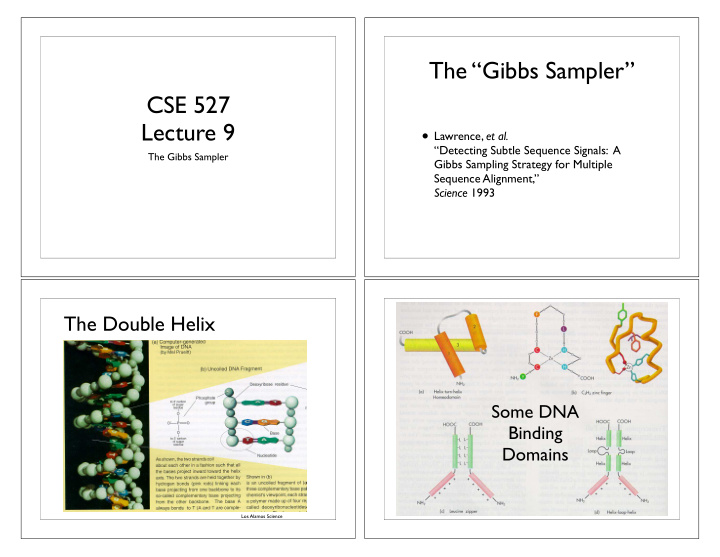



The “Gibbs Sampler” CSE 527 Lecture 9 • Lawrence, et al. “Detecting Subtle Sequence Signals: A The Gibbs Sampler Gibbs Sampling Strategy for Multiple Sequence Alignment,” Science 1993 The Double Helix Some DNA Binding Domains Los Alamos Science
Some History How to Average • Geman & Geman, IEEE PAMI 1984 • Hastings, Biometrika, 1970 An old problem: • Metropolis, Rosenbluth, Rosenbluth, Teller, • n random variables: x 1 , x 2 , . . . , x k • Joint distribution (p.d.f.): & Teller, “Equations of State Calculations by P ( x 1 , x 2 , . . . , x k ) • Some function: Fast Computing Machines,” J. Chem. Phys. f ( x 1 , x 2 , . . . , x k ) • Want Expected Value: 1953 E ( f ( x 1 , x 2 , . . . , x k )) • Josiah Williard Gibbs, 1839-1903, American physicist, a pioneer of thermodynamics
Markov Chain Monte How to Average Carlo (MCMC) E ( f ( x 1 , x 2 , . . . , x k )) = � � � f ( x 1 , x 2 , . . . , x k ) · P ( x 1 , x 2 , . . . , x k ) dx 1 dx 2 . . . dx k • Independent sampling also often hard, but • · · · x 1 x 2 x k not required for expectation • Approach 1: direct integration • MCMC w/ stationary dist = P X t +1 ∼ P ( � � X t +1 | � X t ) (rarely solvable analytically, esp. in high dim) • Simplest & most common: Gibbs Sampling • Approach 2: numerical integration P ( x i | x 1 , x 2 , . . . , x i − 1 , x i +1 , . . . , x k ) (often difficult, e.g., unstable, esp. in high dim) • Algorithm • Approach 3: Monte Carlo integration for t = 1 to � t+ 1 t sample and average: x (1) , � x (2) , . . . � x ( n ) ∼ P ( � � x ) for i = 1 to k do : x )) ≈ 1 � n x ( i ) ) E ( f ( � i =1 f ( � n x t +1 ,i ∼ P ( x t +1 ,i | x t +1 , 1 , x t +1 , 2 , . . . , x t +1 ,i − 1 , x t,i +1 , . . . , x t,k ) • Input: again assume sequences s 1 , s 2 , ..., s k with one length w motif per sequence • Motif model: WMM � Y i,j • Parameters: Where are the motifs? for 1 � i � k , have 1 � x i � | s i |- w +1 1 3 5 7 9 11 ... • “Full conditional”: to calc Sequence i P ( x i = j | x 1 , x 2 , . . . , x i − 1 , x i +1 , . . . , x k ) build WMM from motifs in all sequences except i , then calc prob that motif in i th seq occurs at j by usual “scanning” alg.
Issues Randomly initialize x i ’s for t = 1 to � • Burnin - how long must we run the chain for i = 1 to k to reach stationarity? discard motif instance from s i ; • Mixing - how long a post-burnin sample recalc WMM from rest for j = 1 ... |s i |-w +1 must we take to get a good sample of the Similar to stationary distribution? (Recall that calculate prob that i th motif is at j : MEME, but it individual samples are not independent, and would P ( x i = j | x 1 , x 2 , . . . , x i − 1 , x i +1 , . . . , x k ) average over, may not “move” freely through the sample pick new x i according to that distribution rather than sample from space. Also, many isolated modes.) Variants & Extensions • “Phase Shift” - may settle on suboptimal solution that overlaps part of motif. Periodically try moving all motif instances a few spaces left or right. • Algorithmic adjustment of pattern width: Periodically add/remove flanking positions to maximize (roughly) average relative entropy per position • Multiple patterns per string
Recommend
More recommend